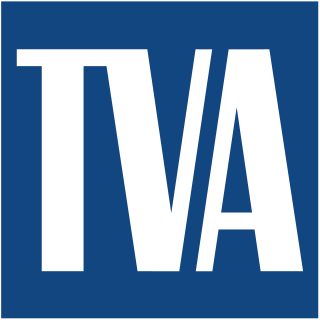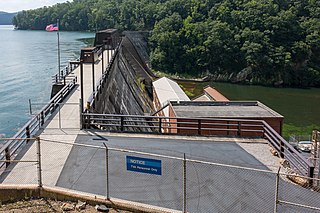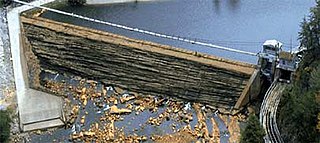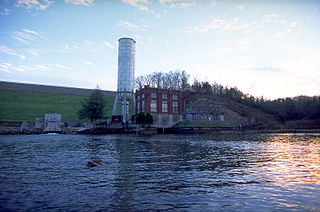Related Research Articles

The Tennessee Valley Authority (TVA) is a federally owned electric utility corporation in the United States. TVA's service area covers all of Tennessee, portions of Alabama, Mississippi, and Kentucky, and small areas of Georgia, North Carolina, and Virginia. While owned by the federal government, TVA receives no taxpayer funding and operates similarly to a private for-profit company. It is headquartered in Knoxville, Tennessee, and is the sixth-largest power supplier and largest public utility in the country.

Perry County is a county located in the U.S. state of Tennessee. As of the 2020 census, the population was 8,366, with an average population density of 20.2 persons per square mile, making it the least densely populated county in Tennessee. Its county seat and largest town is Linden. The county is named after American naval commander and War of 1812 hero Oliver Hazard Perry.
The United States Rural Utilities Service (RUS) administers programs that provide infrastructure or infrastructure improvements to rural communities. These include water and waste treatment, electric power, and telecommunications services. It is an operating unit of the USDA Rural Development agency of the United States Department of Agriculture (USDA). It was created in 1935 as the Rural Electrification Administration (REA), a New Deal agency promoting rural electrification.
A utility cooperative is a type of cooperative that is tasked with the delivery of a public utility such as electricity, water or telecommunications to its members. Profits are either reinvested for infrastructure or distributed to members in the form of "patronage" or "capital credits", which are dividends paid on a member's investment in the cooperative.

Norris Dam is a hydroelectric and flood control structure located on the Clinch River in Anderson County and Campbell County, Tennessee, United States. The dam was the first major project for the Tennessee Valley Authority, which had been created in 1933 to bring economic development to the region and control the rampant flooding that had long plagued the Tennessee Valley. The dam was named in honor of Nebraska Senator George Norris (1861–1944), a longtime supporter of government-owned utilities in general, and supporter of TVA in particular. The infrastructure project was listed on the National Register of Historic Places in 2016.

Nashville Electric Service is one of the 12 largest public electric utilities in the United States, distributing energy to more than 370,000 customers in Middle Tennessee. The NES service area covers 700 square miles (1,800 km2), all of Nashville/Davidson County and portions of the six surrounding counties.

Rural electrification is the process of bringing electrical power to rural and remote areas. Rural communities are suffering from colossal market failures as the national grids fall short of their demand for electricity. As of 2019, 770 million people live without access to electricity – 10.2% of the global population. Electrification typically begins in cities and towns and gradually extends to rural areas, however, this process often runs into obstacles in developing nations. Expanding the national grid is expensive and countries consistently lack the capital to grow their current infrastructure. Additionally, amortizing capital costs to reduce the unit cost of each hook-up is harder to do in lightly populated areas. If countries are able to overcome these obstacles and reach nationwide electrification, rural communities will be able to reap considerable amounts of economic and social development.

Hales Bar Dam was a hydroelectric dam once located on the Tennessee River in Marion County, Tennessee, United States. The Chattanooga and Tennessee River Power Company began building the dam on October 17, 1905, and completed it on November 11, 1913, making Hales Bar one of the first major multipurpose dams and one of the first major dams to be built across a navigable channel in the United States. It began operation on November 13, 1913.

The Internet in the United States grew out of the ARPANET, a network sponsored by the Advanced Research Projects Agency of the U.S. Department of Defense during the 1960s. The Internet in the United States in turn provided the foundation for the worldwide Internet of today.
MLEC may refer to:

The Chattanooga and Tennessee Electric Power Company was formed in 1905 by Josephus C. Guild, Charles E. James and Anthony N. Brady to produce hydroelectric power and improving the navigation of the Tennessee River.

Ocoee Dam Number 1 is a hydroelectric dam on the Ocoee River in Polk County in the U.S. state of Tennessee. The dam impounds the 1,930-acre (780 ha) Parksville Reservoir and is the farthest downstream of four dams on the Toccoa/Ocoee River owned and operated by the Tennessee Valley Authority. Completed in 1911, Ocoee No. 1 was one of the first hydroelectric projects in Tennessee.

Ocoee Dam Number 2 is a hydroelectric dam on the Ocoee River in Polk County in the U.S. state of Tennessee. The dam impounds the Ocoee No. 2 Reservoir and is one of three dams on the Toccoa/Ocoee River owned and operated by the Tennessee Valley Authority. It was completed in 1913.

Blue Ridge Dam is a hydroelectric dam on the Toccoa River in Fannin County, in the U.S. state of Georgia. It is the uppermost of four dams on the Toccoa/Ocoee River owned and operated by the Tennessee Valley Authority. The dam impounds the 3,300-acre (1,300 ha) Blue Ridge Lake on the southwestern fringe of the Blue Ridge Mountains.
Josephus Conn Guild, Jr. was an American businessman and engineer from Chattanooga, Tennessee. As president of the Tennessee Electric Power Company (TEPCO), he became one of the staunchest and most outspoken opponents of the newly formed Tennessee Valley Authority (TVA) in the 1930s. With the help of attorney Wendell Willkie, Guild waged a legal battle that questioned the constitutionality of TVA, culminating in a U.S. Supreme Court case dismissal that forced TEPCO to sell its assets to the new federal agency.

REC Limited, formerly Rural Electrification Corporation Limited, of which Power Finance Corporation Limited (PFC) is holding company, which in turn is under the ownership of the Ministry of Power, the Government of India. It finances and promotes power projects across India. The PSU provides loans to Central/State Sector Power Utilities in the country, State Electricity Boards, Rural Electric Cooperatives, NGOs and Private Power Developers. On 20 March 2019, PFC signed the agreement to acquire a 52.63% controlling stake in REC for ₹14,500 crore (US$1.8 billion). On 28 March, PFC announced that it had completed making the payment for the acquisition and intended to merge REC with itself in 2020. However, REC has maintained that merging PFC-REC is no longer an option.

EPB of Chattanooga, formerly known as the Electric Power Board of Chattanooga, is an American electric power distribution and telecommunications company owned by the city of Chattanooga, Tennessee. EPB serves nearly 180,000 homes and businesses in a 600-square mile area in the greater Chattanooga area and Hamilton County. In 2010, EPB was the first company in the United States to offer 1 Gbit/s high-speed internet over a fiber optic network, over 200 times faster than the national average. As a result, Chattanooga has been called "Gig City" and held up as a national model for deploying the world's fastest internet and the most advanced Smart Grid electric distribution system in the United States. On October 15, 2015, Chattanooga implemented the world's first community-wide 10-gig Internet service.

Wind power in Tennessee has most potential in East Tennessee along the North Carolina border. The state has not passed renewable portfolio standard legislation and there is just one utility-scale wind farm with 15 operating turbines and previously 3 test turbines. The Tennessee Valley Authority (TVA), based in Knoxville, imports wind-generated electricity into its service area which includes Tennessee. US Senator Lamar Alexander from Tennessee is an outspoken critic of wind power.
NTCA - The Rural Broadband Association (NTCA) is a membership association with the goal of improving communications services in rural America. With a membership comprising nearly 850 independent rural American telecommunications companies in forty-four states, NTCA provides training and employee benefit packages to its members. It also advocates rural issues to legislatures, including universal service, rural infrastructure, cybersecurity, telemedicine, and consumer protection.
References
- ↑ "About Us ! MLConnect Broadband". www.mlconnect.com.
- 1 2 "Meriwether Lewis Electric Cooperative". Nonprofit Explorer. ProPublica. Archived from the original on 2022-08-31. Retrieved 31 August 2022.
- 1 2 "Meriwether Lewis Electric Cooperative". Tennessee Valley Authority. Retrieved 29 August 2022.
- ↑ Opinions and Decisions of the Federal Power Commission January 1, 1931-June 30, 1939: Vol 1. Washington: Government Printing Office. 1940. p. 825.
- 1 2 Dowell, Paula; Murray, Matthew N. (October 2001). Potential Impacts of Electric Utility Restructuring on Local Governments in Tennessee. Knoxville: The Center for Business and Economic Research, University of Tennessee. p. 17.
- 1 2 3 Lewis County, Tennessee: History and Families. Paducah, Ky.: Turner Publishing Company. 1995. p. 28. ISBN 9781563111969.
- ↑ "Find Your Cooperative". Touchstone Energy Cooperatives. Retrieved 26 March 2023.
- ↑ "Final Payment Made in Huge TEPCO Deal". The Commercial Appeal. 16 August 1939. Retrieved 17 February 2023.
- ↑ "Making Over Five Counties". The Chattanooga Daily Times. 18 August 1949. Retrieved 17 February 2023.
- ↑ "REA Elects National President". The Tampa Tribune. Associated Press. 25 January 1965. Retrieved 17 February 2023.
- 1 2 Rural Electric and Rural Telephone Supplemental Financing, Hearings before the Committee on Agriculture, House of Representatives. Washington: Government Printing Office. 1967. p. 165. Retrieved 7 September 2022.
- ↑ Levenson, Michael (22 August 2021). "8 Are Dead After Flooding In Tennessee". New York Times. Retrieved 31 August 2022.
- ↑ "Tennessee Co-op Suffers Losses but Works to Restore Power After Flooding". National Rural Electric Cooperative Association. Retrieved 31 August 2022.
- ↑ "Electricity Rates". MLEC.com. Meriwether Lewis Electric Cooperative. Retrieved 29 August 2022.
- ↑ "Duck River may seek TVA alternatives". The Tennessean. Associated Press. 7 August 2003. Retrieved 17 February 2023.
- ↑ Mansfield, Duncan (18 August 2004). "Good news, bad news for TVA". The Knoxville News-Sentinel. Associated Press. Retrieved 17 February 2023.
- ↑ "Rural Development - Tennessee Office: USDA Invests $1.4 Billion in Rural Electric Infrastructure Improvements in 21 States". Targeted News Service. Athena Information Solutions. Retrieved 31 August 2022.
- ↑ "FAQ's | MLConnect Broadband". www.mlconnect.com. Retrieved 2023-06-18.
- ↑ Smith, Chris (25 September 2019). "Erin ranked 4th worst for internet speed, but not for long". The Leaf-Chronicle. USA Today Network. Retrieved 17 February 2023.
- ↑ Kelly, Chris. "ADTRAN signs deal to boost connectivity in Rural America". Total Telecom Online. Retrieved 31 August 2022.
- ↑ "MLConnect hits milestone of 10,000 Subscribers". Lewis County Herald. 9 June 2022. Retrieved 29 August 2022.
- ↑ "Tennessee Co-Ops Receive $6.2 Million in State Grants for Broadband". Athena Information Solutions Pvt. Ltd. Targeted News Service. 20 March 2019. Retrieved 31 August 2022.
- ↑ "Governor Lee, Commissioner Rolfe announce nearly $20 million in broadband accessibility grants". The Tennessean. 9 April 2020. Retrieved 30 August 2022.
- ↑ Ivey, Crystal (14 December 2020). "Connecting Communities During A Pandemic". States News Service. States News Service.
- ↑ "Local Man Assists Emerging Country in Obtaining Power". The Tulia Herald. 17 December 1964. Retrieved 30 August 2022.
- ↑ Hearings Before the Subcommittee of the Committee on Appropriations, House of Representatives, Eighty-Fourth Congress. Washington: Government Printing Office. 1955. p. 558.
- ↑ Hearings before the Committee on Public Works, United States Senate, Eighty-Fifth Congress, Nomination of Arnold R. Jones. Washington: Government Printing Office. 1957. p. 123.
- ↑ "Houston County teachers receive MLEC grants". The Leaf-Chronicle. 3 February 2015. Retrieved 17 February 2023.
- ↑ "Houston County schools receive MLEC grant". Stewart-Houston Times. 7 February 2017. Retrieved 17 February 2023.
- ↑ "Meriwether Lewis Electric Co-op helps local business with loan". Tennessee Electric Cooperative Association. Retrieved 31 August 2022.
- ↑ "Meriwether Lewis EC Helps DCDL Media Expand Services". Tennessee Electric Cooperative Association.
- ↑ "AGRICULTURE SECRETARY VILSACK ANNOUNCES MORE THAN $6 MILLION IN ECONOMIC DEVELOPMENT FUNDING". States News Service. States News Service. 23 September 2009. Retrieved 31 August 2022.
- ↑ "Hugo Knocked Us Down But Not Out". The Item. 12 October 1989. Retrieved 17 February 2023.
- ↑ "Meriwether Lewis Electric Cooperative & Tennessee Valley Authority Support Organizations Responding to COVID-19". Targeted News Service. Athena Information Solutions Pvt. Ltd. 11 June 2020.